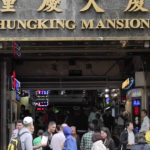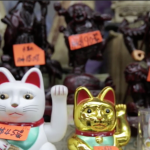A fortunate place: The secrets and truth inside Chungking Mansions
Chungking Mansions launched as a beacon of prosperity in jet-set era Hong Kong. The building’s fame slid into notoriety soon after, and it has lived for 55 years in the spotlight. Many Hong Kong people avoid it, given its reputed sleazy underbelly, or know it only as a multi-storey souk offering exotic flavours and a cheap bed for an hour or more.
But it may disappear from the landscape within a decade, according to those who keep it running.
As the building approaches its November 11 birthday, it is facing an uncertain future. With this project, the South China Morning Post aims to test the myths that surround this building against reality.
What we found has been described as an ecosystem and as a ghetto. An Indian trader remarked to the Post that after staying inside Chungking Mansions for a month, the only thing that he couldn’t find within its walls was “peace of mind”.
Efforts to clean up its image have lifted the building out of its gangland dominated past. And while problems remain, the importance of this building to Hong Kong and those who visit the city remains clear in the stampede of foot traffic that passes through its doors every day.
Designed for function without flair, the building’s heritage remains formally unrecognised or protected. The value of Chungking Mansions is in its people, not its materials. And the materials of Chungking Mansions themselves are, some say, reaching the end of their lifetime.
A product of his environment: resident and Chungking Mansions administration worker Dennis Cheung Ka-yuen.
Chungking Mansions opened in November 1961 during an era of rapid growth in industry, immigration and jet-age tourism to British Hong Kong.
Soon after, the second floor became “The Hongkong Shopping Mart”, catering to tourists with high-end needs, while the basement hosted nightclubs with magicians and hostesses making it a magnet for visiting sailors.
Safety has always been something of an afterthought here, with the building’s rabbit-warren design making it a potent fire hazard.
In 1966, its first major blaze broke out, filling halls with thick smoke and forcing many of its 6,000 residents onto the street – still more blithely ignored the sirens.
The fire caused millions of dollars worth of damage. Dozens more costly blazes were to come.
Chungking Arcade built
1920
A 50,000 sq ft Chungking Arcade with 30 shops is built in the low-rise Tsim Sha Tsui area on Nathan Road.
Chungking Arcade shuttered
1945
The Japanese occupation of Hong Kong forces Chungking Arcade to shut until 1945.
A new beginning
1958
Plans are made to build the tallest building in Tsim Sha Tsui after wealthy Fujian man Jaime Chua Tiampo, living in the Philippines, buys Chungking Arcade for a luxury residential development. The site was chosen for Chungking Mansions to celebrate the 1842 Treaty of Nanking signed in Chongqing, Sichuan, which – among other things – ceded Hong Kong to Britain.
Chungking Mansions opens
November 11, 1961
Construction of Chungking Mansions is finished and the building is awarded an occupancy permit. Lots of 1,000 sq ft are sold for HK$30,000.
‘Super-shopping market’ opens
May 1, 1962
With renovations to the retail floors completed, the place opens to great fanfare with Hong Kong’s first Japanese-style nightclubs, cinemas and restaurants.
Inferno
September 14, 1966
A blaze rips through six shops in one of the earliest reported fires at the building – which would endure many more. Residents, including South China Morning Post staff, report panic at the smoke-filled building as exits and roof access are found locked. Damage is estimated at HK$3 million at the time, or $26.6 million in today’s money.
Five-alarm fire
March 11, 1971
Residents live without reliable water and power supplies after a fire at Tung Wan Kok nightclub. The colonial administration issues a repair order a week later.
A revolution at Chungking Mansions
January 28, 1972
Rising rents along with ultimatum-like reposession notices had driven owners to form a union since the late 1960s. But after fires highlight safety and maintenance issues more residents join forces to form the Incorporated Owners of Chungking Mansions, a body that would represent owners until the present day.
Sin bin
September 16, 1973
“European” prostitutes – usually Australian, Canadian, American and New Zealanders as well as actual European women – come to Chungking Mansions where they make an estimated HK$40,000 a month in “six-month sex assignments” according to sources who spoke to the Post.
Lonely Planet makes a booking
1978
Having been popular in backpacking circles since the early 1970s, the building’s reputation for cheap guest houses became official when Lonely Planet published its review of Chungking Mansions accommodation.
Concrete smashes taxi
July 3, 1985
A chunk of concrete falls from the 15th floor of Chungking Mansions, injuring a taxi driver as it bursts through the windscreen of his car. The incident alerted the Buildings Ordinance Office, which found more risky sections of the ledge.
“Hong Kong’s mansion of ill-repute”
May 19, 1986
The “tawdry silhouette” of Chungking Mansions was meticulously laid bare as the Post’s John Blanton gave his view from inside the building. What he found was “an ambience of ill-repute”, and delicious curry.
Gold smuggling rings exposed
February 8, 1987
Cash-strapped backpackers risked a life sentence to earn thousands by smuggling gold inside their bodies to South Asian nations like Nepal, Bangladesh and India, as well as South Korea. Perhaps it’s not a surprise that the operation had its base in Chungking Mansions.
Transformer room explodes
July 21, 1993
The building was constructed without its own electricity transformer, so in the 1960s one was built. By 1993 it blew up, forcing the building’s management to install another one with greater capacity.
Chungking Express
July 14, 1994
Wong Kar-wai’s Chungking Express – which Sight and Sound magazine named in 2002 among the 10 best films of the previous 25 years – features a drug smuggling operation hosted in the Chungking Mansions retail floors. The release sparked a rush of cinephiles to the building. Long-time guest house owner Wah Fat-chun says the film “saved Chungking Mansions”.
Governor Chris Patten visits
October 12, 1994
Hong Kong’s last colonial governor becomes the city’s first leader to visit Chungking Mansions.
Maintenance issues plague building
1995
In the two years to 1997 the Hong Kong administration issues eight maintenance orders for issues at Chungking Mansions. Property prices fall to $600 per sq ft as the cost of repairs reaches nearly HK$13.5 million after completion in 2001.
Triad cleared of bomb plot
November 8, 1995
A triad member, Tsang Ting-yat, is acquitted of conspiring to cause an explosion after a fire at the China Palace nightclub at Chungking Mansions. The judge rules that the notes of an undercover policeman who had infiltrated the Sun Yee On gang were not accurate after he gave inconsistent testimony.
China takes Hong Kong back
July 1, 1997
The colony of Hong Kong is no more, as an agreed handover happens from the old imperial power of Britain and the economic rising star of China.
CCTV installed
July 20, 1999
First phase of a security project at Chungking Mansions installs 96 cameras despite threats by criminals who say “you install one, I break one”. Anti-triad police help control the gangs.
Media makeover begins
2002
A new committee of owners sets a goal of tackling negative images in news and popular media of Chungking Mansions as dirty, criminal or dangerous.
CCTV control room opens
April 28, 2005
The second phase of the Mansions’ CCTV installation is finished, more than doubling the number of cameras to 208 and building a control room to monitor a wall of screens.
Praise from Time
May 7, 2007
Time Magazine showers Chungking Mansions with praise, labelling it Asia’s best example of globalisation in action.
First non-Chinese owners added to committee
August 2, 2008
Wasim Ahmed and Ghani Rahman become the first two South Asian owners at Chungking Mansions to sit on the organising body of the building, the Incorporated Owners of Chungking Mansions.
CCTV system expands 30 per cent
2009
In 10 years the crime-fighting CCTV system at Chungking Mansions has tripled its coverage to more than 310 cameras, and more are planned.
Fire control
2010
Fire detectors and an emergency escape plan for 95 floors across five towers are brought in, after nearly 50 years and frequent serious blazes at the notorious building.
Johnny English pays a visit
September 29, 2011
British comedian Rowan Atkinson uses conventional means to chase down an unconventional parkour-skilled target on the roof of Chungking Mansions in action comedy Johnny English Reborn.
The ‘ghetto at the centre of the world’
June 1, 2011
Anthropologist Gordon Mathews releases his now-famous, five-year study of Chungking Mansions, Ghetto at the Centre of the World. The work, some of which was conducted from within the building, documents its commercial and human values, and finds 130 different nationalities inside.
Chungking Mansions turns 50
November 11, 2011
The notorious building that has undergone so much drama over its lifetime celebrates its golden jubilee.
Facelift
October 30, 2011
The renovation of the Mansions’ Nathan Road facade is finished with the removal of characteristic advertising, air conditioners and grime.
Suspected Ebola case
August 10, 2014
A Nigerian man, 32, is rushed to hospital four days after arriving in Hong Kong from the Ebola-affected country with early symptoms of the virus – vomiting and diarrhoea. Tests proved negative.
By the mid-’70s Chungking Mansions was already getting an as-yet-unshaken reputation as a discount Xanadu where pleasures of the flesh lived cheek-by-jowl with hippie-trail backpackers. A 1978 Lonely Planet review helped spread the word.
Enter the ‘80s and Chungking Mansions was known for all the wrong reasons. It had become the centre for gold-smuggling rings and European prostitution, and a hangout for the city’s triads.
More global exposure came in 1994 with the release of the arthouse hit Chungking Express, directed by Wong Kar-wai and shot by cinematographer Christopher Doyle. The Incorporated Owners of Chungking Mansions initially refused to let the film be shot at the building, fearing reputation damage. But, as treasurer Wah Chun-fat later recalled, it started a flood of movie makers to use the building in future productions.
“To the great director Wong Kar-wai, it is your shot of ‘Chungking Express’ [which saved] Chungking Mansions.”
– Wah Chun-fat
Wah said on the building’s 50th anniversary he would like to “pay tribute to the great director Wong Kar-wai, it is your shot of ‘Chungking Express’ [which saved] Chungking Mansions”. And since the turn of the millennium, the building has become festooned with cameras – monitored CCTV.
Crime has decreased, but the notorious building’s image didn’t quite turn squeaky clean. Today illegal activities, from teenage drug parties to the dubiously named “compensated dating”, still go on there.
Chungking Mansions’ role as a comfortable zone for traders and refugees from Africa and the sub-continent can not be ignored, whether it’s the tastes of Nigeria being dished up by Mama Africa or a cheap guest house providing shelter for those fleeing the horrors of home. Chungking Mansions has been generous and flexible. We hope to share some of its secrets and its stories.
For more on this story and video go to: http://multimedia.scmp.com/chungking-mansions/index.html?utm_source=biweekly107_20160923&utm_medium=edm&utm_campaign=scmp_focus&emarsys=1&sc_src=email_1700188&sc_llid=47270&sc_lid=139540484&sc_uid=TOHQ5Vnz4D










